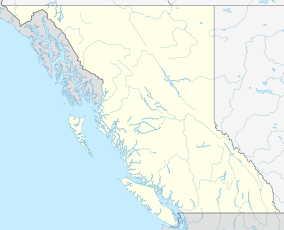Tweedsmuir North Provincial Park and Protected Area
Tweedsmuir North Provincial Park and Protected Area is a provincial park in British Columbia, Canada, which along with Tweedsmuir South Provincial Park and Entiako Provincial Park were once part of Tweedsmuir Provincial Park, then B. C.'s largest park, 9,810 square kilometres (3,790 sq mi) located in the Coast Range.
| Tweedsmuir North Provincial Park | |
|---|---|
Location of Tweedsmuir North in British Columbia | |
| Location | Bulkley-Nechako, British Columbia, Canada |
| Nearest city | Prince George |
| Coordinates | 53°20′35″N 126°27′56″W / 53.34295°N 126.46567°W |
| Area | 446,107 ha (1,722.43 sq mi) |
| Established | May 21, 1938 |
| Governing body | BC Parks |
| Website | Tweedsmuir Provincial Park - North |
 | |
History
editTweedsmuir gained park status in 1938 as the earliest large park established under the BC Parks protected areas system.[2] Tweedsmuir North Provincial Park and Protected Area was re-designated a park and protected area as the latter classification allows resource extraction and other economic activities not permitted in full park designations. Entiako Provincial Park and Protected Area is located on the south flank of the Nechako River watercourse.
Geography
editThe northern portion of the park is a wilderness area. Access is possible via boat, using Ootsa and Whitesail Lakes. The Park is between Burns Lake and Houston. BC Parks provides this explanation: "To get from Chikamin Bay on Whitesail Lake to St. Thomas Bay on Eutsuk Lake in Tweedsmuir Provincial Park, boaters are required to winch their boats over a 600 metre rail portage. Boats to about 7 metres in length can be portaged." Two other common access points are recommended, and maps are provided on the BC Parks web site: Little Andrews Bay Provincial Park and Wistaria Provincial Park.[3] Burns Lake, B.C. is considered to be the northern gateway for fly-in tours for sightseeing, hunting and fishing; these are offered by local outfitters in the town.[4]
Ecology
editThe park is considered to be an almost pristine mountain wilderness. There are many kinds of large mammals in the park including grizzly bears, black bears, wolves, mountain lions, wolverines, boreal woodland caribou, moose, mountain goats and hoary marmots.[5]: 30
The Tweedsmuir-Entiako woodland caribou herd numbered about 500 caribou in 1993.[6]: 1 Their range extends to throughout northern Tweedsmuir Park in alpine and forested habitat in the summer and to the mouth of the Entiako River where the migrates in late winter. By the early 1990s the herd was already declining. Research was undertaken to manage the herd as logging activities were proposed in the area near their winter range.[6]: iii In southern and central B.C. most of the caribou herds "had significantly declined in numbers and in range."[7] By 1985 Stevenson and Hatler had designated the maintenance of Tweedsmuir-Entiako caribou winter range in the land management report as high priority.[6]: 30
References
edit- ^ "Protected Planet | Tweedsmuir Park". Protected Planet. Retrieved 2020-10-11.
- ^ Provincial Parks, Canadian Encyclopedia
- ^ "Tweedsmuir Provincial Park - North and Tweedsmuir Corridor Protected Area". BC Parks. BC Parks. 2017. Retrieved January 28, 2017.
- ^ "British Columbia Travel Guide - Burns Lake". BC Travel & Tourism. BC Travel & Tourism. 2017. Retrieved January 28, 2017.
Burns Lake lays at the bottom of the Bulkley Basin next to the largest Provincial Park in British Columbia - Tweedsmuir Park and the smallest - Deadman's Island Provincial Park
- ^ Eder, Tamara; Kennedy, Gregory (2011). Mammals of Canada. Edmonton, Alberta: Lone Pine. pp. 437. ISBN 9781551058573.
- ^ a b c Cichowski, Deborah B.; Banner, Allen (1993), Management Strategy and Options for the Tweedsmuir-Entiako Caribou Winter Range Land Management (PDF), Province of British Columbia Ministry of Forests, ISBN 07726-1890-9
- ^ Stevenson, S.K.; Hatler, D.F. (1985), Woodland caribou and their habitat in southern and central British Columbia, Land Management Report, vol. 1, Victoria, B.C.: B.C. Ministry of Forests, p. 354
